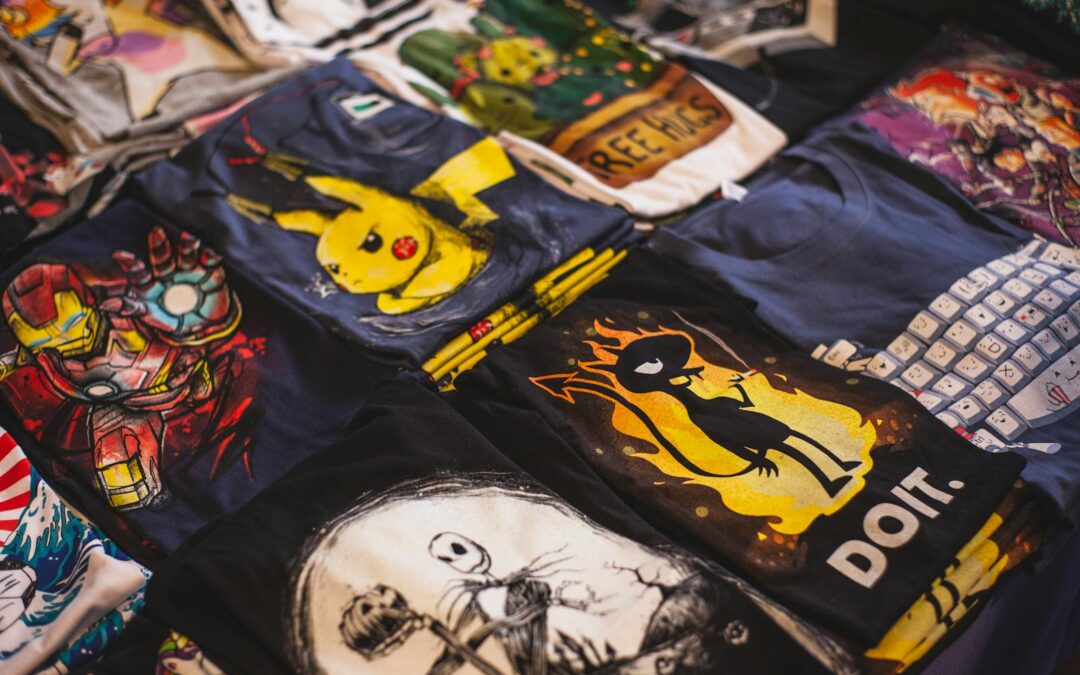Screen printing is a great way to get your company’s logo or message out there. It’s affordable, and the results are high quality and long-lasting. But what is screen printing, exactly? And how does it work? This blog post will explain all that you need to know about screen print transfers, so keep reading!
What Is Screen Printing?
Screen printing is the technique of applying a stenciled design to a flat surface using a mesh screen, plastisol inks, and a squeegee. Fabric and paper are the most common screen-printed materials, but specialized inks enable you to print on wood, metal, plastic, and even glass. The fundamental method for producing impressions uses a fine mesh screen as a stencil to create an imprint of your design on the surface below by pushing ink through it.
The method is also known as “silk screening” or “screen printing,” and while the actual printing process is always quite similar, the way the stencil is created may differ depending on the materials used. In the case of multicolored products, many colors must be applied in separate layers using distinct stencils for each ink.
The History Of Screen Printing

Screen printing is an ancient art form that was first pioneered in China around AD 960 during the Song dynasty. The early version of the technique was used to print patterns onto fabric. Several centuries later, Japanese artisans embraced the practice and began transferring designs onto paper and fabric using a stiff brush to push ink through a mesh screen woven from human hair.
Screen printing made its way to Europe in the 1700s; however, it was not an immediate success due to the expensive cost of silk mesh. However, once the Silk Road became accessible, and the importation of silk became more affordable, screen printing on fabric gradually started gaining popularity among artisans. By 1900, printers had developed photo-sensitive emulsions, which made creating stencil designs much simpler. Consequently, this contributed to the profitability of screen printing.
During the 1930s, artists began experimenting with screen printing as an artistic medium, giving it the name ‘serigraphy’ to distinguish it from industrial printing. By the 1960s, artists like Eduardo Paolozzi and Andy Warhol were using screen printing to create fine art.
Screen printing was dubbed “pop art” in the 1960s when the artist produced numerous copies of a single image, implying that what constitutes good art is questioned. The Marilyn Diptych by Andy Warhol is perhaps the most well-known example of screen printing as an artistic technique.
Nowadays, screen printing is used both for artistic and commercial purposes. One stencil can reproduce the same design hundreds or even thousands of times, making it ideal for large orders of custom clothing.
Why Is Screen Printing Used?

There are many reasons why screen printing is such a popular choice for businesses and individuals alike. Some of the key benefits include:
Easy To Replicate Designs
Screen printing is mostly used because it allows the printer to reproduce a design multiple times easily. Screen printing is an efficient way to create large batches of custom clothing, like company shirts or giveaways.
Vivid Colors And Sharp Lines
The ink used in screen printing is very thick, which means it can produce very vibrant and opaque colors. This is why screen printing is often the preferred method for printing logos and other designs onto t-shirts and other garments. The bold colors and sharp lines of a screen-printed design are sure to turn heads!
Long Lasting
Another great advantage of screen printing is that the designs are very durable and long-lasting. The thick ink used in screen printing can withstand a lot of wear and tear, so your shirts will keep looking great wash after wash.
Affordable
Screen printing is also a very affordable option, especially if you are looking to print in bulk. The initial set-up costs may be higher than some other printing methods, but once you have your screens and inks, you can print as many shirts as you like!
The Screen Printing Process

Below, we share a step-by-step guide on how to create a screen print transfer:
Step One: Create The Design
To start, the printer takes the design they want to create on the finished product and prints it out onto a transparent acetate film. This will be used to create the stencil.
Step Two: Coat Screen With Emulsion
The application instructions for this are quite simple to grasp, so don’t fret. First, the screen needs to be coated with a light-sensitive emulsion. Once the screen is dry, it is placed over the acetate sheet and exposed to ultraviolet light. This hardens the emulsion everywhere except for where the design has been printed on the acetate, creating a negative of the design.
If a multi-colored design is to be produced, a separate screen must be used for each layer of paint because the printer will have to draw multiple stencils and line them up properly in order to provide a seamless design.
Step Three: The Emulsion Is Washed Off To Create The Stencil
Once the screen has been exposed to light for the specified amount of time, only the design will remain on the screen. The unhardened emulsion is rinsed off, resulting in a clear outline of where ink should be placed.
After the screen is dried, make any final adjustments to the design so that it is as accurate as possible to the original. The stencil can now be used.
Step 4; The Item Is Prepared For Print
The screen is then placed on the printing press. The item or garment being printed is laid down flat on the printing board beneath the screen. There are a variety of presses to choose from, including manual and automatic designs, but most modern commercial printers use an automated rotary carousel printer since it allows numerous screens to operate at once. This sort of printer may also be used to apply the various color layers in quick succession for multicolored prints.
Step 5: The Ink Is Pressed Through The Screen Onto The Item
With the screen in place on top of the item, ink is poured into the top of the screen. A blade or squeegee is then used to press the ink through the holes in the stencil and onto the surface.
Next, the printed product is placed in a dryer, which ‘cures’ the ink and creates a smooth, colorfast finish. The final product will be examined and washed carefully to remove any residue before it goes to its new owner.
And there you have it! That’s how screen printing works in a nutshell. As you can see, it’s a fairly straightforward process that yields great results.
Differences Between Screen Printing And Digital Printing
Now that you know a little bit more about screen printing, you may be wondering how it differs from digital printing. Let’s take a look.
The most obvious difference between these two printing methods is the cost. Screen printing requires more set-up time and materials, so it tends to be more expensive than digital printing, especially for small batches.
Asides from this, direct-to-garment (DTG) digital printing, like inkjet computer printers, employs a distinct fabric printer that transfers an image directly onto textiles. It differs from screen printing in that a digital printer is used to apply the design directly to the cloth. Because there’s no stencil, this method may be used to print complicated designs because it allows for simultaneous application of many colors rather than separate layer adjustments.
However, screen printing has some major advantages over digital printing, including greater durability and vibrancy of colors. Screen printing inks are also more resistant to fading and washing, making them a better choice for garments that will see a lot of wear. And because screen printing uses thicker inks, it can create a raised (3D) effect that is not possible with digital printing.
What Is The Difference Between Heat transfer printing And Screen Printing?

Heat transfer printing process is the name given to any form of print that uses heat to bind a design to cloth. The pattern is printed on a material coated with heat-reactive adhesive, commonly known as sublimation or transfer paper.
When a heat press is used on the transfer paper, the adhesives react to the heat and adhere to the surface of the cloth beneath. This process often uses a series of low heat transfers and high heat transfers.
Heat transfer printing is a cheaper and more convenient option for small prints or personalized designs. It’s also able to produce better results than screen printing for photographic images or on items like bags, hats, or footwear that have an awkward shape.
The heat transfer process can be paired with digital techniques to create interesting and unique designs. With digital heat transfer printing, a design is created on the computer and printed onto white transfer paper.
The design is then cut out using a machine called a plotter, which follows a digital outline to get accurate results. The finished full-color transfers are placed on the desired spot on the garment or accessory and are then heat-treated to bind it to the fabric.
Does Screen Printing Ink Wash Out?
If a design has been properly screen printed with heat-treated washable ink by a qualified expert, it should not fade. The printer must make sure that the ink is set according to the manufacturer’s instructions to ensure a colorfast finish.
Depending on the type of ink and the material utilized, the proper drying temperature and period may differ, so if they want to produce a long-lasting, washable item, printers must follow the directions meticulously.
Conclusion
We hope this guide has given you a good overview of the screen printing process. Screen printing is a great way to create high-quality, custom prints. However there is a steep learning curve, requires a lot of space, and larger initial investment to get started.




